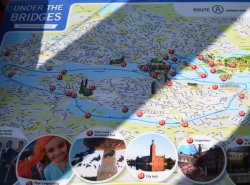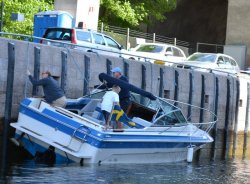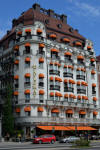Round The World and other travels
A frequent flyer's collection of trip diaries
This is: Russia & Sweden 2014
Thank you for the music
 Sunday
dawned bright, clear and already warm, the mirror-like surface of
Lake Mälaren giving impressive reflections of City Hall and the
buildings of Gamla Stan. Almost unbelievably, we had arrived at the
last full day of the trip, but one where the afternoon would deliver
one of the true highlights, with our visit to ABBA: The Museum.
Water plays a vital part in Stockholm's physical layout and in the
city's life generally, so we thought that an ideal morning pastime
would be a boat trip around some of its more important waterways.
(Apart from anything else, it would help us to conserve our energy for
later in the day!) Accordingly, following another Executive Lounge
breakfast, we retraced Saturday's initial footsteps and made our way
across the eastern side of Gamla Stan to the Strömkajen
departure point.
Sunday
dawned bright, clear and already warm, the mirror-like surface of
Lake Mälaren giving impressive reflections of City Hall and the
buildings of Gamla Stan. Almost unbelievably, we had arrived at the
last full day of the trip, but one where the afternoon would deliver
one of the true highlights, with our visit to ABBA: The Museum.
Water plays a vital part in Stockholm's physical layout and in the
city's life generally, so we thought that an ideal morning pastime
would be a boat trip around some of its more important waterways.
(Apart from anything else, it would help us to conserve our energy for
later in the day!) Accordingly, following another Executive Lounge
breakfast, we retraced Saturday's initial footsteps and made our way
across the eastern side of Gamla Stan to the Strömkajen
departure point.
Under the Bridges
The tour lasted 1hr 50mins, taking us first into the adjacent Nybroviken inlet, then between the islands of Skeppsholmen and Djurgården towards the Slussen lock (adjacent to our hotel), where we left seawater behind and entered Lake Mälaren. The route proceeded westwards past the islands of Langholmen and Lilla Essingen, where a nifty U-turn then saw us passing between Lilla Essingen and Stora Essingen. The return was via the southern coast of Södermalm and the Hammarby locks. Being the first run of the day, the sailing had a reasonably healthy load without being in the least overcrowded, which made for a pleasurable experience.
| RIGHT and BELOW: The boat initially made for the Slussen lock in order to pass into Lake Mälaren. |
 |
 |
 |
 |
 |
 |
 |
 |
 |
 |
 |
 |
LEFT: 'Under the Bridges'
tour route |
 |
|
|
||
| RIGHT: Oops! And today's lesson is: when the lock is lowering the water level, don't forget to leave some slack in the rope when tying up your boat! |
 |
 |
 |
 |
 |
LEFT: The return route was via the southern coast of Södermalm |

 |
 |
 |
 |
 |
|
| ABOVE: Walking towards Djurgården | ||
On arrival back at Strömkajen, we strolled into the city centre and soon found an Asian-themed, counter-service restaurant called icha icha, where I had a healthy and light salmon salad for lunch. We were going to follow this up by taking a tram out to Djurgården, but having sat around for most of the morning, we felt well up to walking instead. (In case anyone is puzzled at this point, I should point out that the island of Djurgården is connected to the mainland at Strandvägen by a bridge, used by road traffic, trams and pedestrians.)
ABBA: The Museum
For many years, Djurgården has been home to attractions such as the Vasa maritime museum, the Skansen open-air museum and the Gröna Lund amusement park; indeed I visited the two museums during my first time in Stockholm in 1992. The island is now home to a new museum, celebrating and paying tribute to a Swedish pop sensation from the 1970s that took the world by storm: ABBA. It may seem an odd port of call for somebody who is a committed classical music fan, but I can honestly say that ABBA was one of very few acts from the world of popular music that won me over, and I still remember many of their hits with affection to this day. So this was always going to be a genuine highlight of the trip for both Bruce and me.
And we weren't disappointed! From the moment that we entered (some 15 minutes ahead of the time on our tickets), we were enthralled, as the initial displays took us through the backgrounds of the four musicians and the formation of ABBA. Not surprisingly, much was made of the Eurovision Song Contest win in 1974 with Waterloo, a turning point in the group's success story. The displays in general contained all the artefacts that you might expect, including video clips, costumes, album covers and awards; however there was also a pronounced emphasis on interactive features making use of present-day electronic wizardry, essentially inviting the braver visitors to become a 'fifth member' of ABBA. It certainly made for an entertaining spectator sport!
One slightly spooky display featured 'Benny's piano', a self-playing piano linked to Benny Andersson's own instrument at home, which would reproduce within the museum anything played by the former group member, in real time. You just never knew when it might burst into life!
| BELOW: 'Without a song or a dance, what are we?' | |||||
 |
 |
 |
 |
 |
 |
 |
 |
 |
 |
 |
 |
When the thoroughly enjoyable visit came to an end, a short and easy ferry ride took us back to the Slussen ferry terminal, leaving an equally short and easy walk to get back to base.
Djurgården dinner

 In
line with normal practice, we had a quick rest and a drink in the
Executive Lounge before going out for dinner. On this occasion, we
were heading straight back to the very place we had just been: the
island of
Djurgården, where we had an
8pm reservation at the highly recommended Ulla Windbladh
restaurant. We both instantly liked the place: it seemed elegant,
but in a completely unpretentious way, with a menu and culture that
focused on making a really good job of serving traditional Swedish
fare. We also liked the friendly, down-to-earth service.
In
line with normal practice, we had a quick rest and a drink in the
Executive Lounge before going out for dinner. On this occasion, we
were heading straight back to the very place we had just been: the
island of
Djurgården, where we had an
8pm reservation at the highly recommended Ulla Windbladh
restaurant. We both instantly liked the place: it seemed elegant,
but in a completely unpretentious way, with a menu and culture that
focused on making a really good job of serving traditional Swedish
fare. We also liked the friendly, down-to-earth service.
The next day, we were due to go our separate ways, when I would take the direct SAS late-morning flight to Edinburgh, while Bruce planned to travel back to London Heathrow on British Airways. But the ferry ride back to Slussen seems an appropriate point at which to bring down the curtain on this latest adventure: less than two hours before midnight yet in conditions that showed scarcely a hint of approaching darkness, with my stomach full of good food and wine and with an unseasonably warm breeze caressing my skin, I was able to ponder the sights, sounds and tastes of two highly contrasting countries and three amazing Northern European cities. Quite simply, it had been another utterly fabulous trip.